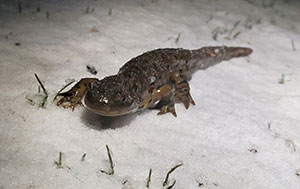UWs Biodiversity Institute to Host Laramie Salamander Migration Initiative
Published March 09, 2022

Each spring, on rainy nights, hundreds of Western tiger salamanders -- taking up residence in the yards of Laramie homes -- find their way to LaBonte Park. There, they breed and lay thousands of eggs in the park’s pond.
But the small amphibians need some assistance crossing the roads safely around the park, and that’s where the University of Wyoming’s Biodiversity Institute comes in. The institute hosts the Laramie Salamander Migration Initiative, which includes identifying salamanders locally; a Salamander Saturday event April 9; and having the public help with salamander migration nights during the spring.
“The Laramie Salamander Migration Initiative is a new community science project from the Biodiversity Institute, and there are three opportunities for the community to get involved,” says Mason Lee, senior project coordinator of the Biodiversity Institute. “This project was started because, although this population of tiger salamanders is in the center of Laramie and literally in some of our backyards, we know almost nothing about this population.”
For many years, UW students and community members have descended upon LaBonte Park on rainy spring evenings to help move salamanders out of the road and across to the park.
“These little salamanders are no match for cars. Last year, the volunteers moved over 250 salamanders to safety,” Lee says. “This project builds on their efforts in previous years to protect this population.”
The first opportunity of the initiative involves getting community members to report where they see salamanders, whether it be in their yards, on walks or found dead in the street. The Biodiversity Institute is collecting this information to get a better idea of where the salamanders are spending most of their time.
“We know they breed in LaBonte, and they move from the neighborhoods surrounding the park where they overwinter. But, we don’t know how many blocks they are actually covering during their migration,” Lee says. “There also might be another population in town, or in towns around Wyoming, that we don’t know about.”
Adult tiger salamanders are difficult to find because they spend much of the year underground and, when they are above ground, they are primarily nocturnal. When they reach LaBonte Park, they breed and lay thousands of eggs in the pond. After a few weeks, the eggs will hatch, and small aquatic salamander young emerge. Toward the end of the summer, these tiger salamanders undergo a metamorphosis to become terrestrial adult salamanders. They migrate back to the yards around LaBonte Park, where they spend the rest of the year in underground burrows until the following spring.
Reports of salamander sightings can be entered on an online form at www.wyobiodiversity.org/index.php/community-science/laramie-salamander-migration-initiative/report-salamander-sighting.
The second part of the initiative is a free, family-friendly event called Salamander Saturday, which is scheduled April 9 from 10:30 a.m.-1:30 p.m. in the Berry Biodiversity Conservation Center. The event will include activities for kids -- salamander storytime, games and crafts -- and adults, who will obtain information on helping salamanders and can play a salamander trivia game to win a prize. There also will be an opportunity to meet Tim and Tad, the Biodiversity Institute’s very special tiger salamanders.
While not finalized, the list of event partners includes the Albany County Public Library, the city of Laramie, graduate students from the UW Program in Ecology and Windy City Pet Store.
The third part of the initiative is the actual salamander migration nights. The city will provide high-visibility vests for volunteers’ safety, and volunteers will be trained in how to pick salamanders up off the road while being mindful of oncoming traffic. Volunteers will need to wear warm, waterproof clothing and headlamps. Although salamanders migrate while it rains, the rain often turns to snow, Lee advises.
Volunteers will patrol Ninth and Canby streets and pick up any salamanders they see. They will bring them to researchers who will be stationed around the pond. Researchers will collect information on the sex and size of the salamanders before releasing them, Lee says.
“Prospective volunteers will be asked to keep an eye on our ‘Migration Nights’ webpage, where we have a forecast for which nights look likely for salamander movement. But they also can expect an email from us on evenings that seem to have a high probability,” Lee explains. “We know the salamanders make at least two large migrations; males first, and then the females.”
To register or volunteer for the salamander migration nights, go to www.wyomingbiodiversity.org/index.php/community-science/laramie-salamander-migration-initiative/migration-nights.
For more information about the Laramie Salamander Migration Initiative, go to www.wyomingbiodiversity.org/index.php/community-science/laramie-salamander-migration-initiative.
The UW Biodiversity Institute fosters conservation of biodiversity through scientific discovery, creative dissemination, education and public engagement. In this setting, scientists, citizens, students and educators come together to share a wealth of perspectives on the study and appreciation of biodiversity -- from microbes to poetry and ecosystems to economics. Learn more at www.wyomingbiodiversity.org.

